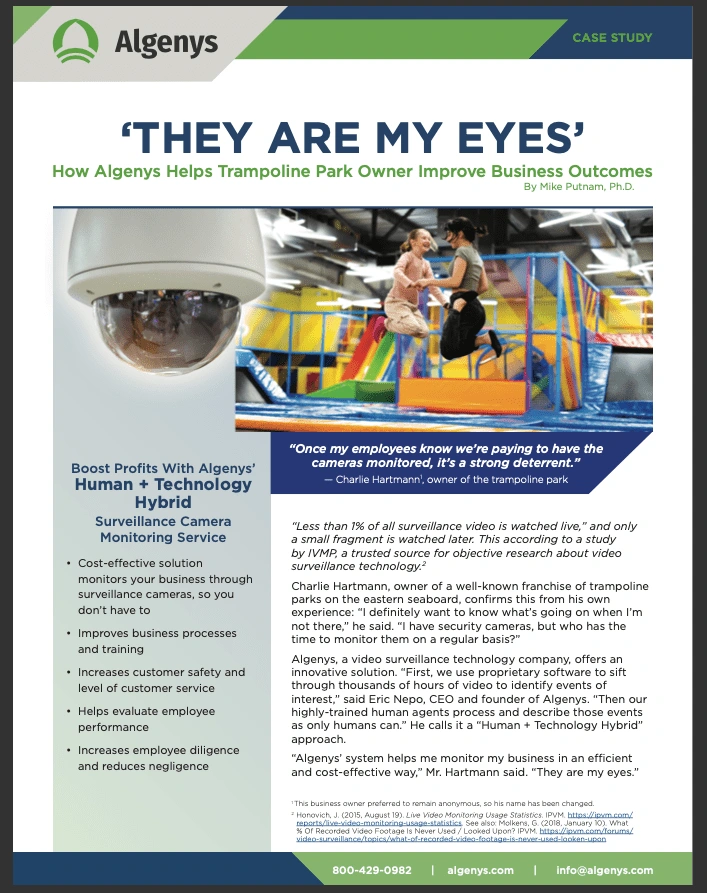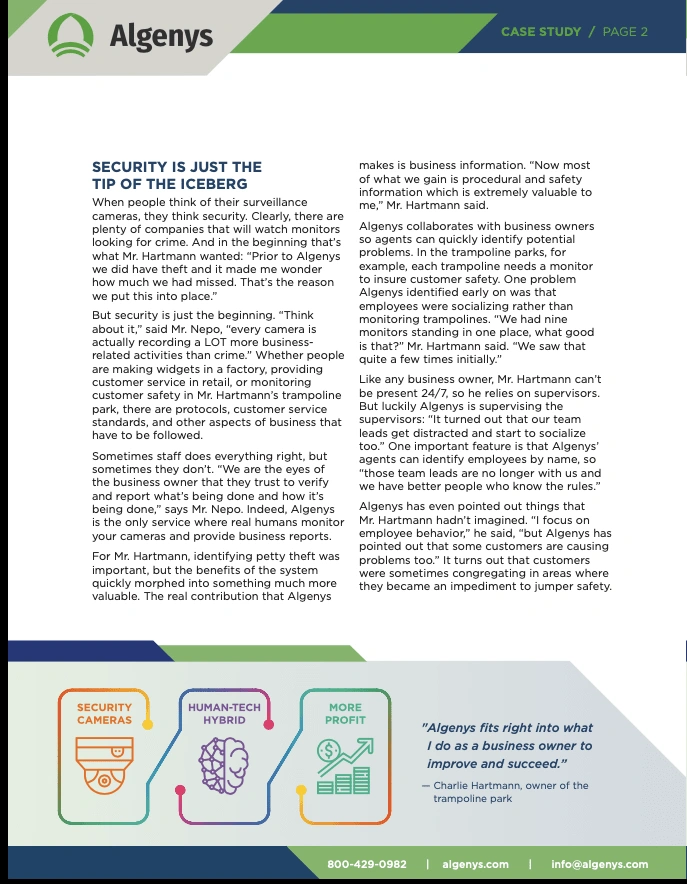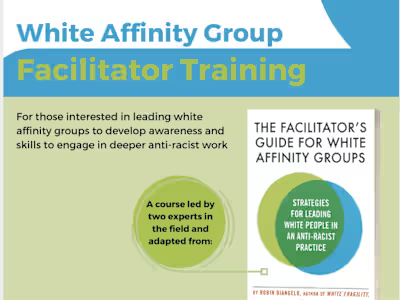B2B Case Study 2: Algenys uncovers unseen business opportunities
Overview 🔎
Case Study Title: “‘They are My Eyes’: How Algenys Helps Trampoline Park Owner Improve Business Outcomes”
My client: Algenys, a video surveillance technology company that developed a distinctive “human + technology hybrid” surveillance solution.
Goal: Reveal the many unexpected ways Algenys’ innovative surveillance system improves a trampoline park owner’s business operations and bottom line.
Narrative: Customer success stories, aka case studies, follow a simple but powerful narrative structure: the challenges the customer faced, the solutions my client provided, and the results they helped the customer achieve.
Challenges ⛰
1. As with B2B Case Study #1, I knew little about my client’s business before I started this project. My client shared documentation with me, but I was able to research the industry independently and write about it like a subject matter expert.
2. The audience for this case study is any business owner who deploys video surveillance cameras in a physical location—that’s a big audience. This means I had to describe this complex technical product and its many benefits in the most accessible language possible.
3. Most companies have thousands of hours of surveillance video, but only a minuscule fraction of that is ever put to use. This makes for a challenging narrative in three ways.
First, prospects need to accept the likelihood that their surveillance systems aren’t producing ROI.
Second, and more challenging, Algenys is asking prospects to imagine that problems may be taking place under their noses that they’re not aware of. To paraphrase my client, it’s very hard to imagine what you don’t know and don’t see—it’s a tough sell!
Finally, and most importantly, those unseen problems must be presented as opportunities for substantial business growth so prospects have the confidence to buy.
My Process 🧩
Leave no stone un-turned: Research my client, their industry, competitors, the customer for the case study, the challenges they were facing, the solutions that my client provided, and the results the customer achieved based on those solutions.
Create questionnaire #1: Compile a detailed questionnaire to interview a representative from my client’s company who is familiar with the customer’s case. The questionnaire follows the classic case study “problem, solution, results” narrative outlined above.
Interview, connect, and learn from my client: The structure of the interview follows the classic narrative, but an interview is much more than a stale question and answer session. Without rapport and human connection, the story will be flat, with no drive. The first thing I do in an interview is make the person comfortable, get them to laugh a little and relax. When the serious questions start, I use active listening techniques to make them feel heard. This way, I’m able to draw out stories, details, and specific examples with careful follow-up questions. Finally, I elicit the emotional experiences of the key players to make the story dramatic, relatable, and give the readers a strong sense of the stakes involved.
Create questionnaire #2: Based on the results of the first interview, I compile a second questionnaire for the customer (again, a representative familiar with the ways in which my client’s services helped them succeed). This questionnaire follows the same structure as the first.
Interview, connect, and learn from your customer: Conduct the interview, using the same strategies and techniques outlined above.
Analyze and annotate the transcripts: Sifting through the transcripts in detail allows me to identify themes, powerful quotations, and story elements that fit the case study narrative (problem, solution, results). I also identify compelling ways that the interviews complement each other to help me weave them together into a cohesive story that carries the reader through the narrative.
Draft the case study: Drawing on my background research and both interviews, I focus my writing on the most powerful quotations and story elements to showcase the challenges and success stories revealed in the interviews. I focus on quotations for several reasons. First, the human voice lends authenticity and authority to the narrative. Second, through their voices, the reader gets to know and relates to the key players in the story. And finally, the most powerful quotations not only drive home the most important points, but can also be extracted from the final version of the case study and easily repurposed for social media posts, email newsletters, or other content.
Submit the case study: My first drafts rarely require more than minor revisions. Nevertheless, I include two rounds of revisions in my price.



Results 💪
First, I started the case study with a dramatic quote from a trusted source: “Less than 1% of all surveillance video is ever watched.” This captures the reader’s attention and alerts them to the problem that while they have security cameras, they’re not actually using them.
I then quote my client’s customer to give the reader a sense that they’re not alone, that this is a common issue: “I have security cameras, but who has the time to monitor them?”
Second, a visually strong sidebar next to the introductory paragraphs lists the numerous benefits of Algenys’ solution right up front (this gives busy readers the option to easily skim). Thus, as the reader begins to see themselves in the narrative, the sidebar establishes the many potential benefits that this customer enjoyed. Working closely with both the narrative and visual elements of the case study contributed to its success.
Third, for Algenys’ prospects, theft detection is the only clear use case for surveillance video. In fact, the customer I interviewed told me that theft was the sole reason he hired Algenys in the first place. It was only after Algenys’ systems were in place for some time that he came to understand how many unexpected benefits the solution was providing.
With even the happiest of customers, drawing out intriguing stories with compelling quotations is not easy. I’ve conducted over 200 interviews and developed expertise that allowed me to solicit story after story about how Algenys’ solution improved training, evaluation, customer service, customer safety (critical in a trampoline park), employee performance, employee diligence, and decreased employee negligence.
Takeaways 📣
As noted by my client, the challenge for this case study was to help prospects imagine what they don’t know—that is, that there are problems in their business that they’re unaware of. And most importantly, those hidden problems must be presented as opportunities for substantial business growth.
To do this, I carefully planned the narrative elements and closely collaborated with the graphic designer that I brought on board for the project. This helped the case study succeed for a number of reasons.
Creating long-form content like case studies is critical for your business’ marketing effort.
Everybody loves a testimonial. But typical testimonials are often quite superficial. Case studies are extended testimonials that educate the reader about your solutions and prove that you can deliver the goods. Case studies give prospects the confidence they need to buy.
Far from being a single marketing asset, case studies can be quickly repurposed to fortify content for social media, email newsletters, and blog posts.
As a Certified SEO copywriter I know that long-form content is great for SEO. Google values content that reflects Experience, Expertise, Authoritativeness, and Trustworthiness (commonly referred to as E-E-A-T). Google wants to be helpful to its users and guide them to the best content. A well-written and deeply researched case study will meet Google’s standards for excellence and boost your SEO.
Ready to supercharge your marketing
with a compelling case study? 🚀
Let’s talk soon! I’d love to learn about your project
and share my thoughts. 🤝
Like this project
Posted Feb 20, 2024
Case study showcases how Algenys’ video surveillance solution uncovered several hidden business opportunities for a local trampoline park franchise owner.
Likes
0
Views
9





